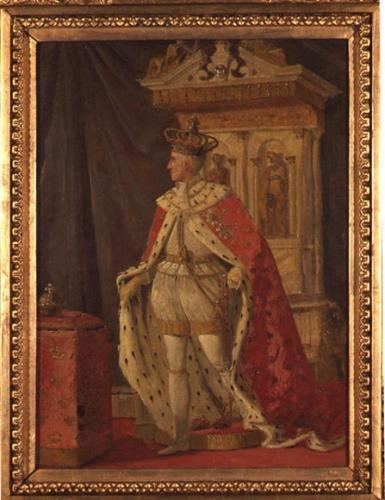 | ||
The Throne Chair of Denmark (Danish and Norwegian: Danmarks tronstol; also: salvingsstol, kroningsstol) is the physical representation of the Throne of the Kingdom of Denmark (since 1671) and of the Throne of the Kingdom of Norway (between 1671 and 1814).
Contents
According to legend, the Throne Chair is made of the horn of unicorns. In reality, it is made from Norwegian narwhal tusks. It is guarded by three life-size silver lions, based on Biblical references, and was a symbol of the absolute monarchy of the Twin Kingdoms.
The Throne Chair is located in the Castle of Rosenborg in Copenhagen.
Throne Chair
Following the 1660 introduction of absolute monarchy in Denmark and Norway, King Frederick III (r. 1648–1670) ordered a throne chair to be created. The Throne Chair was made between 1662 and 1671 by Bendix Grodtschilling. During the reign of King Christian V (r. 1670–1699), gilt figures were added to the chair.
Both the Throne Chair and the silver lions were inspired by the Biblical Throne of King Solomon, which was guarded by twelve lions, as described in I Kings 10:
18 Moreover the king made a great throne of ivory, and overlaid it with the finest gold. 19 There were six steps to the throne, and the top of the throne was round behind; and there were arms on either side by the place of the seat, and two lions standing beside the arms. 20 And twelve lions stood there on the one side and on the other upon the six steps; there was not the like made in any kingdom.
The Throne Chair was used at coronations between 1671 and 1840. When absolute monarchy was replaced by constitutional monarchy in 1849, kings were no longer crowned or anointed, wherefore the Throne Chair lost its practical function.
Even though Norway was formally an independent realm with its own throne, Denmark's Throne Chair was de facto also Norway's until 1814.
Lions
The Throne Chair is guarded by three lions of silver. They have the same size as natural lions, and each has the weight of 130 kilos. Their eyes, their mane, and their rump are covered with pure gold. They were made between 1665 and 1670 by Ferdinand Kübich.
On 20 November 1905, when delegates of the Norwegian parliament entered the Christian VII Palace in Copenhagen in order to offer Prince Carl Norway's Throne, they were met—and stopped—by the lions. This historic moment has been immortalised by photographer Peter Elfelt. Based on Elfelt's photograph, painter Paul Fischer made a famous painting. Several versions of this painting have existed, and one is included in the art collections in the Castle of Oslo.
The silver lions are still in use outside Rosenborg, mainly when protecting the castrum doloris of Kings.
